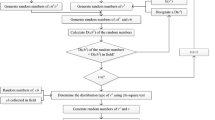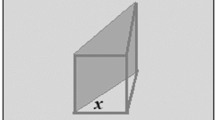Abstract
This study takes sluice foundation rock mass in Datengxia Hydropower Station, China as an example to examine two-dimensional (2D) discrepancies in fracture geometric factors and connectivity between field-collected and stochastically modeled discrete fracture networks (DFNs). We discover that the trace lengths of field-collected and corresponding modeled DFNs diverge, especially with relatively large lengths. A new variable called minimum spacing sequence (MSS) is proposed, which lists minimum spacing between each fracture midpoint and all the other fracture midpoints. The probability density function curve of MSS shows that the fracture locations do not follow a homogeneous (Poisson) model. The following is performed to examine whether the differences will result in noticeable DFN application errors. The 2D fracture connectivity, which is calculated by depth-first search algorithm, is applied to quantify the discrepancies between field-collected and statistically modeled 2D DFNs. Results show that the statistically modeled DFNs have small clustered fracture path numbers and ratios but with considerably large maximum and average lengths for paths (or for paths longer than certain thresholds) owing to the concentration disadvantage and connection advantage of scattered fractures. We comprehensively compare different 2D DFNs (including field-collected DFN, totally modeled DFNs, DFNs with field fracture size, and DFNs with field fracture locations) and conclude that generating statistically modeled DFNs with identical connectivity features is extremely difficult. Mechanical means that consider connections among fractures are recommended for DFN applications.














Similar content being viewed by others
References
Adler PM, Thovert JF, Mourzenko VV (2012) Fractured porous media. Oxford University Press, Oxford
Anders MH, Laubach SE, Scholz CH (2014) Microfractures: a review. J Struct Geol 69:377–394
Baghbanan A, Jing L (2008) Stress effects on permeability in a fractured rock mass with correlated fracture length and aperture. Int J Rock Mech Min Sci 45:1320–1334
Bauer M, Toth TM (2017) Characterization and DFN modelling of the fracture network in a Mesozoic Karst Reservoir: Gomba Oilfield, Paleogene Basin, Central Hungary. J Petrol Geol 40:319–334
Belayneh MW, Matthäi SK, Blunt MJ, Rogers SF (2009) Comparison of deterministic with stochastic fracture models in water-flooding numerical simulations. AAPG Bull 93:1633–1648
Bondy A, Murty U (2010) Graph theory (graduate texts in mathematics). Springer, London
Bonneau F, Caumon G, Renard P (2016) Impact of a stochastic sequential initiation of fractures on the spatial correlations and connectivity of discrete fracture networks. J Geophys Res Sol Ea 121:5641–5658
Bonnet E, Bour O, Odling NE, Davy P, Main I, Cowie P, Berkowitz B (2001) Scaling of fracture systems in geological media. Rev Geophys 39:347–383
Chen JP, Xiao SF, Wang Q (1995) Three dimensional network modelling of stochastic fractures. Northeast norm University Press, Changchun
Chen JP, Shi BF, Wang Q (2005) Study on the dominant orientations of random fractures of fractured rock mass. Chin J Rock Mech Eng 24:241–245
Davy P, Goc RL, Darcel C (2013) A model of fracture nucleation, growth and arrest, and consequences for fracture density and scaling. J Geophys Res Sol Ea 118:1393–1407
Einstein HH, Veneziano D, Baecher GB, Oreilly KJ (1983) The effect of discontinuity persistence on rock slope stability. Int J Rock Mech Min Sci Geomech Abstr 20:227–236
Elmo D, Stead D, Eberhardt E, Vyazmensky A (2013) Applications of finite/discrete element modeling to rock engineering problems. Int J Geomech 13:565–580
Elmo D, Rogers S, Stead D, Eberhardt E (2014) Discrete fracture network approach to characterise rock mass fragmentation and implications for geomechanical upscaling. Min Tech 123:149–161
Esmaieli K, Hadjigeorgiou J, Grenon M (2010) Estimating geometrical and mechanical REV based on synthetic rock mass models at Brunswick Mine. Int J Rock Mech Min Sci 47:915–926
Fang JL, Zhou FD, Tang ZH (2017) Discrete fracture network modelling in a naturally fractured carbonate reservoir in the Jingbei Oilfield, China. Energies 10:183
Grenon M, Hadjigeorgiou J (2003) Open stope stability using 3D joint networks. Rock Mech Rock Eng 36:183–208
Han XD, Chen JP, Wang Q, Li YY, Zhang W, Yu TW (2016) A 3D fracture network model for the undisturbed rock mass at the Songta Dam Site based on small samples. Rock Mech Rock Eng 49:611–619
Hao YH, Yeh TJ, Xiang JW, Lllman WA, Ando K, Hsu KC, Lee CH (2008) Hydraulic tomography for detecting fracture zone connectivity. Ground Water 46:183–192
Hestir K, Long JCS (1990) Analytical expressions for the permeability of random two-dimensional Poisson fracture networks based on regular lattice percolation and equivalent media theories. J Geophys Res 952(B13):21565–21581
Hudson JA, Harrison JP (1997) Engineering rock mechanics: an introduction to the principles. Pergamon, London
Jayaram N, Baker JW (2008) Statistical tests of the joints distribution of spectral acceleration values. B Seismol Soc Am 98:2231–2243
Jing L (2003) A review of techniques, advances and outstanding issues in numerical modelling for rock mechanics and rock engineering. Int J Rock Mech Min Sci 40:283–353
Kulatilake PHSW, Wu TH (1984) Estimation of mean trace length of discontinuities. Rock Mech Rock Eng 17:215–232
Kulatilake PHSW, Wu TH, Wathugala DN (1990) Probabilistic modelling of joint orientation. Int J Numer Anal Methods Geomech 14:325–350
Kulatilake PHSW, Wang LQ, Tang HM, Liang Y (2011) Evaluation of rock slope stability for Yujian River dam site China by block theory analyses. Comput Geotech 38:846–860
Lee H, Jeon S (2011) An experimental and numerical study of fracture coalescence in pre-cracked specimens under uniaxial compression. Int J Solids Struct 15:979–999
Lee JS, Veneziano D, Einstein HH (1990). Hierarchical fracture trace model, In: Hustrulid, W., Johnson, G.A. (Eds.), Rock mechanics contributions and challenges; Proceedings of the 31st US Rock Mechanics Symposium, Balkema, Rotterdam, pp. 261–268
Lei Q, Latham JP, Tsang CF, Xiang J, Lang P (2015) A new approach to upscaling fracture network models while preserving geostatistical and geomechanical characteristics. J Geophys Res: Sol Ea 120:4784–4807
Li MC, Han S, Zhou SB, Zhang Y (2018) An improved computing method for 3D mechanical connectivity rates based on a polyhedral simulation model of discrete fracture network in rock masses. Rock Mech Rock Eng 51:1789–1800
Liu J, Wang J (2018) Stress evolution of rock-like specimens containing a single fracture under uniaxial loading: a numerical study based on particle flow code. Geotech Geol Eng 36:567–580
Liu Y, Wang Q, Chen JP, Song SY, Zhan JW, Han XD (2018) Determination of geometrical REVs based on volumetric fracture intensity and statistical tests. Appl Sci 8:800
Malinouskaya I, Thovert JF, Mourzenko VV, Adler PM, Shekhar R, Agar S, Rosero E, Tsenn M (2014) Fracture analysis in the Amellago outcrop and permeability predictions. Petrol Geosci 20:93–107
Odling NE (1992) Network properties of a two-dimensional natural fracture pattern. Pure Appl Geophys 138:95–114
Odling NE, Webman I (1991) A “conductance” mesh approach to the permeability of natural and simulated fracture patterns. Water Resour Res 27:2633–2643
Ozkaya S, Mattner J (2003) Fracture connectivity from fracture intersections in borehole image logs. Comput Geosci-UK 29:143–153
Priest SD, Hudson JA (1981) Estimation of discontinuity spacing and trace length using scanline surveys. Int J Rock Mech Min Sci Geomech Abstr 18:183–197
Sisavath S, Mourzenko V, Genthon P, Thovert JF, Adler PM (2004) Geometry, percolation and traport properties of fracture networks derived from line data. Geophys J Int 157:917–934
Song SY, Sun FY, Chen JP, Zhang W, Han XD, Zhang XD (2017) Determination of RVE size based on the 3D fracture persistence. Q J Eng Geol Hydrogeol 50:60–68
Stacey TR, Armstrong R, Terbrugge PJ (2015) Experience with the development and use of a simple DFN approach over a period of 30 years. Min Tech 124:178–187
Tang YB, Li M, Li XF (2017) Connectivity, formation factor and permeability of 2D fracture network. Phys A 483:319–329
Thovert JF, Adler PM (2004) Trace analysis for fracture networks of any convex shape. Geophys Res Lett 31:L22502
Thovert JF, Mourzenko VV, Adler PM, Nussbaum C, Pinetters P (2011) Faults and fractures in the Gallery 04 of the Mont Terri rock laboratory: characterization, simulation and application. Eng Geol 117:39–51
Thovert JF, Mourzenko VV, Adler PM, Nussbaum C (2014) Statistical analysis of the fracture network. In: Nussbaum C, Bossart P (eds) Mont Terri Rock Laboratory, 1st edn. Swisstopo, Wabern
Vazaios I, Vlachopoulos N, Diederichs MS (2017) Integration of lidar-based structural input and discrete fracture network generation for underground applications. Geotech Geol Eng 35:2227–2251
Vazaios I, Farahmand K, Vlachopoulos N, Diederichs MS (2018) Effects of confinement on rock mass modulus: a synthetic rock mass modelling (SRM) study. J Rock Mech Geotech Eng 10:436–456
Wang CY, Sun Y (1990) Oriented microfractures in Cajon pass drill cores: stress field near the SAN Andreas Fault. J Geophys Res 95:135–142
Welch J, Davies R, Knipe R, Tueckmantel C (2009) A dynamic model for fault nucleation and propagation in mechanically layered section. Tectonophysics 474:473–492
White CD, Willis BJ (2000) A method to estimate length distributions from outcrop data. Math Geol 32:389–419
Wong LNY, Einstein HH (2009) Systematic evaluation of cracking behavior in specimens containing single flaws under uniaxial compression. Int J Rock Mech Min Sci 46:239–249
Wu X, Kulatilake PHSW, Tang HM (2011) Comparison of rock discontinuity mean trace length and density estimation methods using discontinuity data from an outcrop in Wenchuan area, China. Comput Geotech 38:258–268
Xu CS, Dowd P (2010) A new computer code for discrete fracture network modelling. Comput Geosci-UK 36:292–301
Xu C, Dowd PA, Mardia KV, Fowell RJ (2006) A connectivity index for discrete fracture networks. Math Geol 38(5):611–634
Yang H, Shan RL, Zhang JX, Wu FM, Guo ZM (2018) Mechanical properties of frozen rock mass with two diagonal intersected fractures. Int J Rock Mech Min Sci 28:631–638
Yao C, He C, Yang JH, Jiang QH, Huang JS, Zhou CB (2019) A novel numerical model for fluid flow in 3D fractured porous media based on an equivalent matrix-fracture network. Geofluids 2019:9736729
Zhang W, Chen JP, Chen HE, Xu DZ, Li Y (2013) Determination of RVE with consideration of the spatial effect. Int J Rock Mech Min Sci 61:154–160
Zhang W, Zhao QH, Huang RQ, Ma DH, Chen JP, Xu PH, Que JS (2017a) Determination of representative volume element considering the probability that a sample can represent the investigated rock mass at Baihetan Dam Site, China. Rock Mech Rock Eng 50:2817–2825
Zhang W, Zhao QH, Chen JP, Huang RQ, Yuan XQ (2017b) Determining the critical slip surface of a fractured rock slope considering preexisting fractures and statistical methodology. Landslides 14:1253–1263
Acknowledgements
This work was supported by the National Nature Science Foundation of China (Grant numbers: 41877220 and 41472243), the National Nature Key Science Program Foundation (Grant number: 41330636), and the National Key Research and Development Plan (Grant number: 2017YFC1501000).
Author information
Authors and Affiliations
Corresponding authors
Ethics declarations
Conflict of interest
The authors declare no conflict of interest.
Additional information
Publisher's Note
Springer Nature remains neutral with regard to jurisdictional claims in published maps and institutional affiliations.
Rights and permissions
About this article
Cite this article
Zhang, W., Fu, R., Tan, C. et al. Two-Dimensional Discrepancies in Fracture Geometric Factors and Connectivity Between Field-Collected and Stochastically Modeled DFNs: A Case Study of Sluice Foundation Rock Mass in Datengxia, China. Rock Mech Rock Eng 53, 2399–2417 (2020). https://doi.org/10.1007/s00603-019-02029-7
Received:
Accepted:
Published:
Issue Date:
DOI: https://doi.org/10.1007/s00603-019-02029-7




